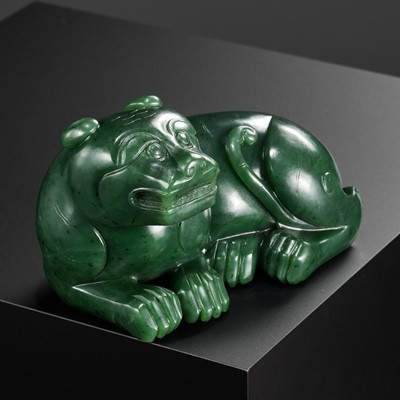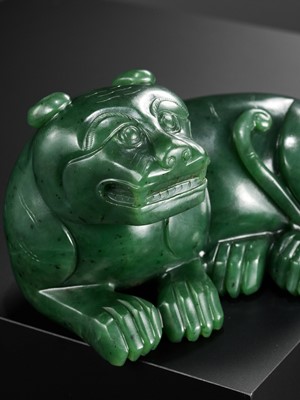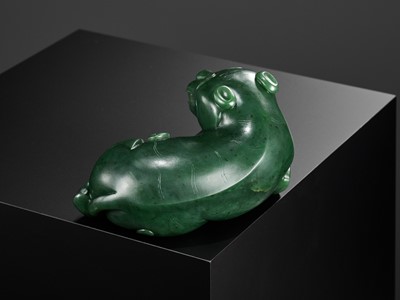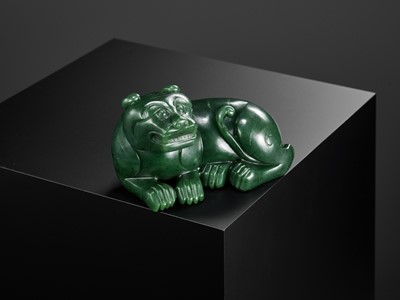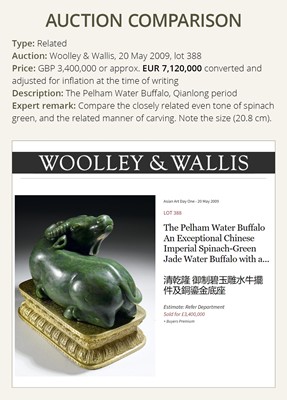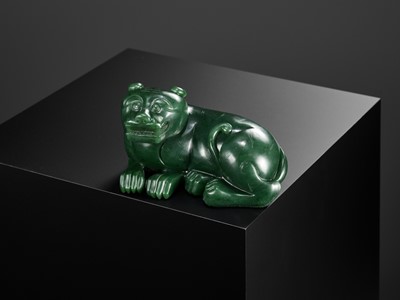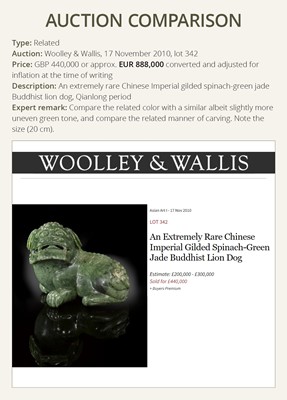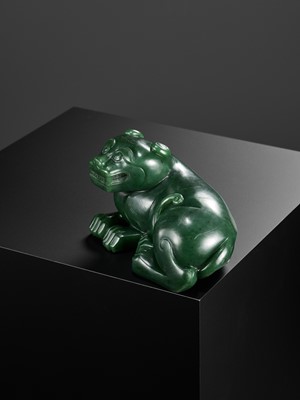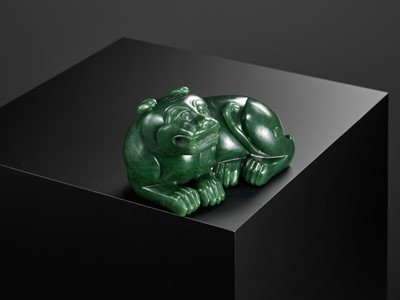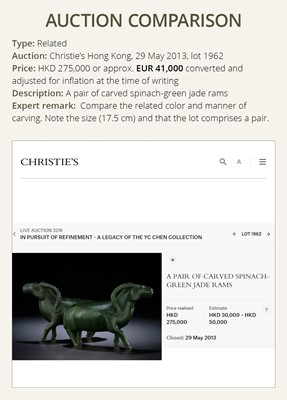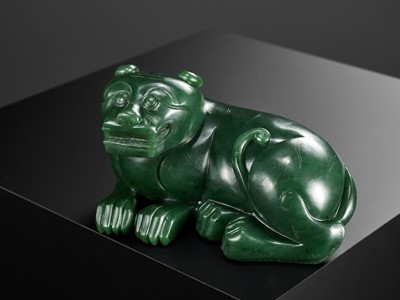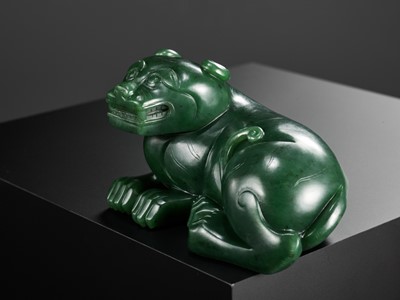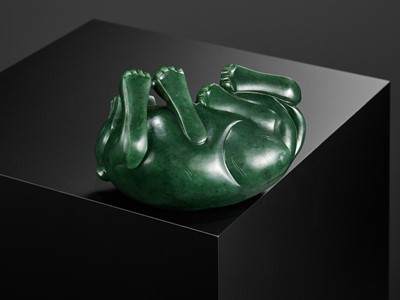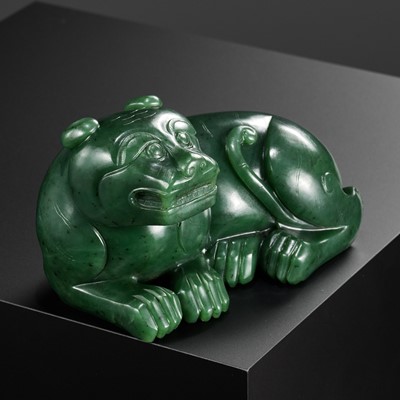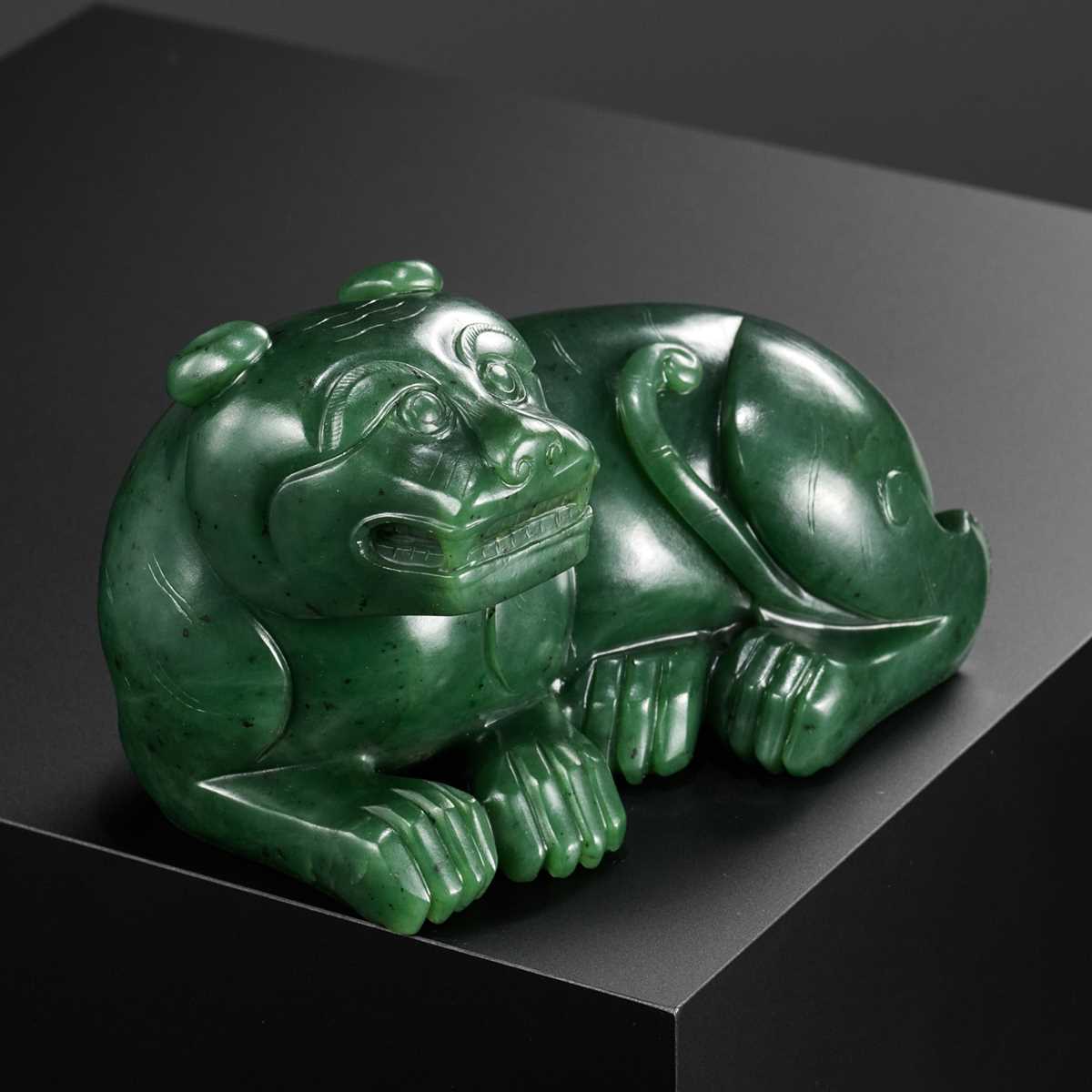11th Oct, 2023 11:00
THREE-DAY AUCTION - Fine Chinese Art / 中國藝術集珍 / Buddhism & Hinduism
28
A RARE SPINACH-GREEN JADE FIGURE OF A TIGER, SECOND HALF OF THE QIANLONG PERIOD
乾隆時期後半葉菠菜綠玉虎
Sold for €6,500
including Buyer's Premium
China, c. 1760-1795. Carved from a large boulder, the tiger rests in a recumbent pose with its legs tucked beneath its body and its tail curling to the side. The body is neatly incised with thin stripes, and its face is well detailed with large round eyes, thick arched brows, and thin whiskers. The tiger bares its sharp teeth in a fierce snarl, wrinkling its face, and laying its ears back. The prominent, menacing claws are another distinct feature, clearly identifying the animal as the biggest and most dangerous of all felines, also known as ‘Man Eater’ in some cultures.
The superbly polished stone of an even and remarkably pure deep spinach-green tone with few minute dark flecks and icy veins. Possibly Khotan jade.
Provenance: French trade.
Condition: Superb condition with minimal wear. The stone with few natural fissures, some of which may have developed into small hairline cracks.
Weight: 1,488.3 g
Dimensions: Length 15.3 cm
Please click here to read the full description
Prior to the Qianlong period, jade carvings in China were largely confined to small-sized items such as scholar’s objects, pendants, plaques, and palm-sized vessels, due to the rarity of quality jade. Most jade quarries were a great distance from the capital and were outside the jurisdiction of the early Qing empire until the 1750s. In the middle of Qianlong’s reign in 1759, the emperor expanded his rule into the Xinjiang territory while quelling the Dzungar Khanate and the Altishahr Khojas rebellions, making a large supply of jade material from the region available to the empire.
After 1760, when the Kingdom of Yutian (modern-day Xinjiang province) was brought under Chinese influence, the fine raw jade boulders from that area were readily available to Chinese carvers. The region known as Khotan, now in Xinjiang province, is particularly famous for its fine nephrite jade. With these materials, and the encouragement of the emperor, the jade lapidaries of the second half Qianlong period were able to produce remarkable feats of carving.
Large jade animal carvings represent some of the finest jade products of the early Qing dynasty, leading to the heights of achievement associated with the reign of the Qianlong emperor. Animals including tigers, horses, and elephants were popular, as were mythical beasts such as the qilin or the Buddhist lion.
Tigers have been of great importance in Chinese culture since the earliest surviving records of Chinese history, with the character 虎 appearing on Shang-era oracle bones. In ancient China, the Siberian and Bengal tigers were common in the northeast and southwest respectively, and tigers figure prominently in Chinese myth, astrology, poetry, painting, and other fields. Most prominently, the tiger has long been regarded as a major symbol of masculine yang energy and the king of the animals.
Literature comparison:
Compare a related large spinach-green jade Buddhistic lion, 19.8 cm wide, date to the Qianlong period, formerly in the collections of R.C. Bruce, the 3rd Baron Alington of Crichel, and the Hon. Mrs Mary Anna Marten OBE, illustrated by S.C.Nott in Chinese Jade Throughout the Ages, Rutland, Vermont, 1973, pl. LXIII.
Auction result comparison:
Type: Related
Auction: Woolley & Wallis, 17 November 2010, lot 342
Price: GBP 440,000 or approx. EUR 888,000 converted and adjusted for inflation at the time of writing
Description: An extremely rare Chinese Imperial gilded spinach-green jade Buddhist lion dog, Qianlong period
Expert remark: Compare the related color with a similar albeit slightly more uneven green tone, and compare the related manner of carving. Note the size (20 cm).
Auction result comparison:
Type: Related
Auction: Woolley & Wallis, 20 May 2009, lot 388
Price: GBP 3,400,000 or approx. EUR 7,120,000 converted and adjusted for inflation at the time of writing
Description: The Pelham Water Buffalo, Qianlong period
Expert remark: Compare the closely related even tone of spinach green, and the related manner of carving. Note the size (20.8 cm).
Auction result comparison:
Type: Related
Auction: Christie’s Hong Kong, 29 May 2013, lot 1962
Price: HKD 275,000 or approx. EUR 41,000 converted and adjusted for inflation at the time of writing
Description: A pair of carved spinach-green jade rams
Expert remark: Compare the related color and manner of carving. Note the size (17.5 cm) and that the lot comprises a pair.
点此阅读中文翻译 (Chinese Translation)
乾隆時期後半葉菠菜綠玉虎
中國,約1760-1795年。 老虎由一整塊玉石雕刻而成,呈臥姿,雙腿收在身體下方,尾巴捲曲到一側。玉虎大眼圓睜,濃眉,細須,齜牙咧嘴,似乎在發出咆哮,耳朵向後仰。表面拋光精美,呈均勻且非常純淨的深菠菜綠色調,帶有一些微小的黑色斑點和冰冷的内沁。可能是和田玉。
來源:法國古玩交易。
品相:狀況極佳,極少磨損。玉石有輕微天然裂隙,有的可能已發展成細小的裂紋。
重量:1,488.3 克
尺寸:長 15.3 厘米
文獻比較:
比較一件相近的乾隆菠菜綠玉雕太獅如意,寬19.8 厘米,曾藏於R.C. Bruce,第三代Alington of Crichel男爵和Mary Anna Marten OBE夫人閣下,見S.C.Nott,《Chinese Jade Throughout the Ages》,佛蒙特州拉特蘭市,1973年,頁LXIII。
拍賣比較:
形制:相近
拍賣:Woolley & Wallis,2010年11月17日,lot 342
價錢:GBP 440,000(相當今日EUR 888,000)
描述:乾隆御製菠菜綠玉雕太獅
專家註釋:比較相近的顏色 ,儘管雖然綠色調稍微不均勻,以及比較相近的雕刻風格。請注意尺寸 (20 厘米)。
拍賣比較:
形制:相近
拍賣:Woolley & Wallis,2009年5月20日,lot 388
價錢:GBP 3,400,000(相當今日EUR 7,120,000)
描述:清乾隆御製碧玉雕水牛擺件及銅鎏金底座
專家註釋:比較非常相近的菠菜綠色調 均勻,以及相近的雕刻風格。請注意尺寸 (20.8 厘米)。
拍賣比較:
形制:相近
拍賣:香港佳士得,2013年5月29日,lot 1962
價錢:HKD 275,000(相當今日EUR 41,000)
描述:碧玉瑞羊擺件一對
專家註釋:比較相近的顏色和雕刻風格。請注意尺寸 (17.5 厘米),以及此為一對。
China, c. 1760-1795. Carved from a large boulder, the tiger rests in a recumbent pose with its legs tucked beneath its body and its tail curling to the side. The body is neatly incised with thin stripes, and its face is well detailed with large round eyes, thick arched brows, and thin whiskers. The tiger bares its sharp teeth in a fierce snarl, wrinkling its face, and laying its ears back. The prominent, menacing claws are another distinct feature, clearly identifying the animal as the biggest and most dangerous of all felines, also known as ‘Man Eater’ in some cultures.
The superbly polished stone of an even and remarkably pure deep spinach-green tone with few minute dark flecks and icy veins. Possibly Khotan jade.
Provenance: French trade.
Condition: Superb condition with minimal wear. The stone with few natural fissures, some of which may have developed into small hairline cracks.
Weight: 1,488.3 g
Dimensions: Length 15.3 cm
Please click here to read the full description
Prior to the Qianlong period, jade carvings in China were largely confined to small-sized items such as scholar’s objects, pendants, plaques, and palm-sized vessels, due to the rarity of quality jade. Most jade quarries were a great distance from the capital and were outside the jurisdiction of the early Qing empire until the 1750s. In the middle of Qianlong’s reign in 1759, the emperor expanded his rule into the Xinjiang territory while quelling the Dzungar Khanate and the Altishahr Khojas rebellions, making a large supply of jade material from the region available to the empire.
After 1760, when the Kingdom of Yutian (modern-day Xinjiang province) was brought under Chinese influence, the fine raw jade boulders from that area were readily available to Chinese carvers. The region known as Khotan, now in Xinjiang province, is particularly famous for its fine nephrite jade. With these materials, and the encouragement of the emperor, the jade lapidaries of the second half Qianlong period were able to produce remarkable feats of carving.
Large jade animal carvings represent some of the finest jade products of the early Qing dynasty, leading to the heights of achievement associated with the reign of the Qianlong emperor. Animals including tigers, horses, and elephants were popular, as were mythical beasts such as the qilin or the Buddhist lion.
Tigers have been of great importance in Chinese culture since the earliest surviving records of Chinese history, with the character 虎 appearing on Shang-era oracle bones. In ancient China, the Siberian and Bengal tigers were common in the northeast and southwest respectively, and tigers figure prominently in Chinese myth, astrology, poetry, painting, and other fields. Most prominently, the tiger has long been regarded as a major symbol of masculine yang energy and the king of the animals.
Literature comparison:
Compare a related large spinach-green jade Buddhistic lion, 19.8 cm wide, date to the Qianlong period, formerly in the collections of R.C. Bruce, the 3rd Baron Alington of Crichel, and the Hon. Mrs Mary Anna Marten OBE, illustrated by S.C.Nott in Chinese Jade Throughout the Ages, Rutland, Vermont, 1973, pl. LXIII.
Auction result comparison:
Type: Related
Auction: Woolley & Wallis, 17 November 2010, lot 342
Price: GBP 440,000 or approx. EUR 888,000 converted and adjusted for inflation at the time of writing
Description: An extremely rare Chinese Imperial gilded spinach-green jade Buddhist lion dog, Qianlong period
Expert remark: Compare the related color with a similar albeit slightly more uneven green tone, and compare the related manner of carving. Note the size (20 cm).
Auction result comparison:
Type: Related
Auction: Woolley & Wallis, 20 May 2009, lot 388
Price: GBP 3,400,000 or approx. EUR 7,120,000 converted and adjusted for inflation at the time of writing
Description: The Pelham Water Buffalo, Qianlong period
Expert remark: Compare the closely related even tone of spinach green, and the related manner of carving. Note the size (20.8 cm).
Auction result comparison:
Type: Related
Auction: Christie’s Hong Kong, 29 May 2013, lot 1962
Price: HKD 275,000 or approx. EUR 41,000 converted and adjusted for inflation at the time of writing
Description: A pair of carved spinach-green jade rams
Expert remark: Compare the related color and manner of carving. Note the size (17.5 cm) and that the lot comprises a pair.
点此阅读中文翻译 (Chinese Translation)
乾隆時期後半葉菠菜綠玉虎
中國,約1760-1795年。 老虎由一整塊玉石雕刻而成,呈臥姿,雙腿收在身體下方,尾巴捲曲到一側。玉虎大眼圓睜,濃眉,細須,齜牙咧嘴,似乎在發出咆哮,耳朵向後仰。表面拋光精美,呈均勻且非常純淨的深菠菜綠色調,帶有一些微小的黑色斑點和冰冷的内沁。可能是和田玉。
來源:法國古玩交易。
品相:狀況極佳,極少磨損。玉石有輕微天然裂隙,有的可能已發展成細小的裂紋。
重量:1,488.3 克
尺寸:長 15.3 厘米
文獻比較:
比較一件相近的乾隆菠菜綠玉雕太獅如意,寬19.8 厘米,曾藏於R.C. Bruce,第三代Alington of Crichel男爵和Mary Anna Marten OBE夫人閣下,見S.C.Nott,《Chinese Jade Throughout the Ages》,佛蒙特州拉特蘭市,1973年,頁LXIII。
拍賣比較:
形制:相近
拍賣:Woolley & Wallis,2010年11月17日,lot 342
價錢:GBP 440,000(相當今日EUR 888,000)
描述:乾隆御製菠菜綠玉雕太獅
專家註釋:比較相近的顏色 ,儘管雖然綠色調稍微不均勻,以及比較相近的雕刻風格。請注意尺寸 (20 厘米)。
拍賣比較:
形制:相近
拍賣:Woolley & Wallis,2009年5月20日,lot 388
價錢:GBP 3,400,000(相當今日EUR 7,120,000)
描述:清乾隆御製碧玉雕水牛擺件及銅鎏金底座
專家註釋:比較非常相近的菠菜綠色調 均勻,以及相近的雕刻風格。請注意尺寸 (20.8 厘米)。
拍賣比較:
形制:相近
拍賣:香港佳士得,2013年5月29日,lot 1962
價錢:HKD 275,000(相當今日EUR 41,000)
描述:碧玉瑞羊擺件一對
專家註釋:比較相近的顏色和雕刻風格。請注意尺寸 (17.5 厘米),以及此為一對。
Zacke Live Online Bidding
Our online bidding platform makes it easier than ever to bid in our auctions! When you bid through our website, you can take advantage of our premium buyer's terms without incurring any additional online bidding surcharges.
To bid live online, you'll need to create an online account. Once your account is created and your identity is verified, you can register to bid in an auction up to 12 hours before the auction begins.
Intended Spend and Bid Limits
When you register to bid in an online auction, you will need to share your intended maximum spending budget for the auction. We will then review your intended spend and set a bid limit for you. Once you have pre-registered for a live online auction, you can see your intended spend and bid limit by going to 'Account Settings' and clicking on 'Live Bidding Registrations'.
Your bid limit will be the maximum amount you can bid during the auction. Your bid limit is for the hammer price and is not affected by the buyer’s premium and VAT. For example, if you have a bid limit of €1,000 and place two winning bids for €300 and €200, then you will only be able to bid €500 for the rest of the auction. If you try to place a bid that is higher than €500, you will not be able to do so.
Online Absentee and Telephone Bids
You can now leave absentee and telephone bids on our website!
Absentee Bidding
Once you've created an account and your identity is verified, you can leave your absentee bid directly on the lot page. We will contact you when your bids have been confirmed.
Telephone Bidding
Once you've created an account and your identity is verified, you can leave telephone bids online. We will contact you when your bids have been confirmed.
Classic Absentee and Telephone Bidding Form
You can still submit absentee and telephone bids by email or fax if you prefer. Simply fill out the Absentee Bidding/Telephone bidding form and return it to us by email at office@zacke.at or by fax at +43 (1) 532 04 52 20. You can download the PDF from our Upcoming Auctions page.
How-To Guides
How to Create Your Personal Zacke Account
How to Register to Bid on Zacke Live
How to Leave Absentee Bids Online
How to Leave Telephone Bids Online
中文版本的操作指南
创建新账号
注册Zacke Live在线直播竞拍(免平台费)
缺席投标和电话投标
Third-Party Bidding
We partner with best-in-class third-party partners to make it easy for you to bid online in the channel of your choice. Please note that if you bid with one of our third-party online partners, then there will be a live bidding surcharge on top of your final purchase price. You can find all of our fees here. Here's a full list of our third-party partners:
- 51 Bid Live
- EpaiLive
- ArtFoxLive
- Invaluable
- LiveAuctioneers
- the-saleroom
- lot-tissimo
- Drouot
Please note that we place different auctions on different platforms. For example, in general, we only place Chinese art auctions on 51 Bid Live.
Bidding in Person
You must register to bid in person and will be assigned a paddle at the auction. Please contact us at office@zacke.at or +43 (1) 532 04 52 for the latest local health and safety guidelines.
